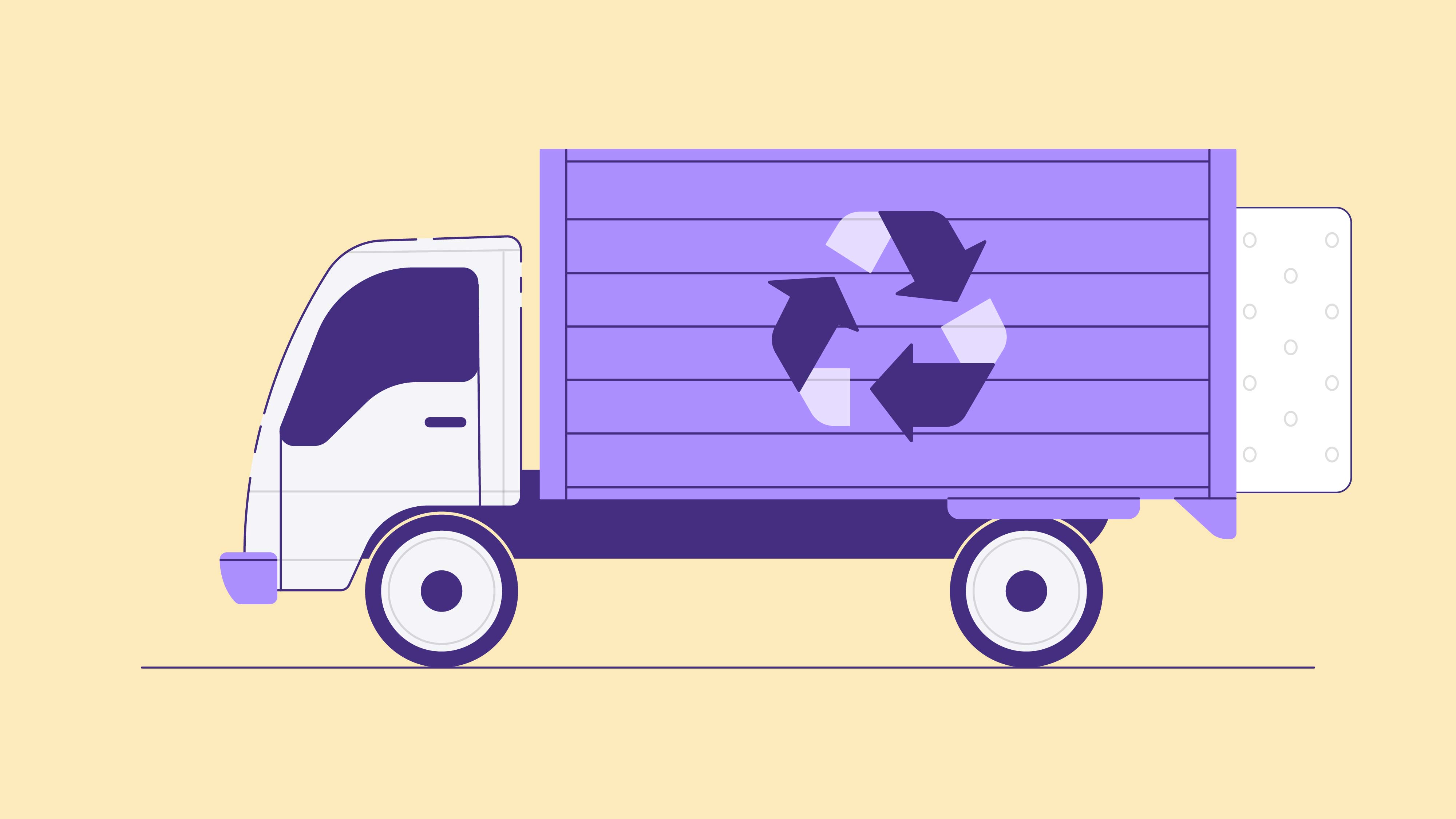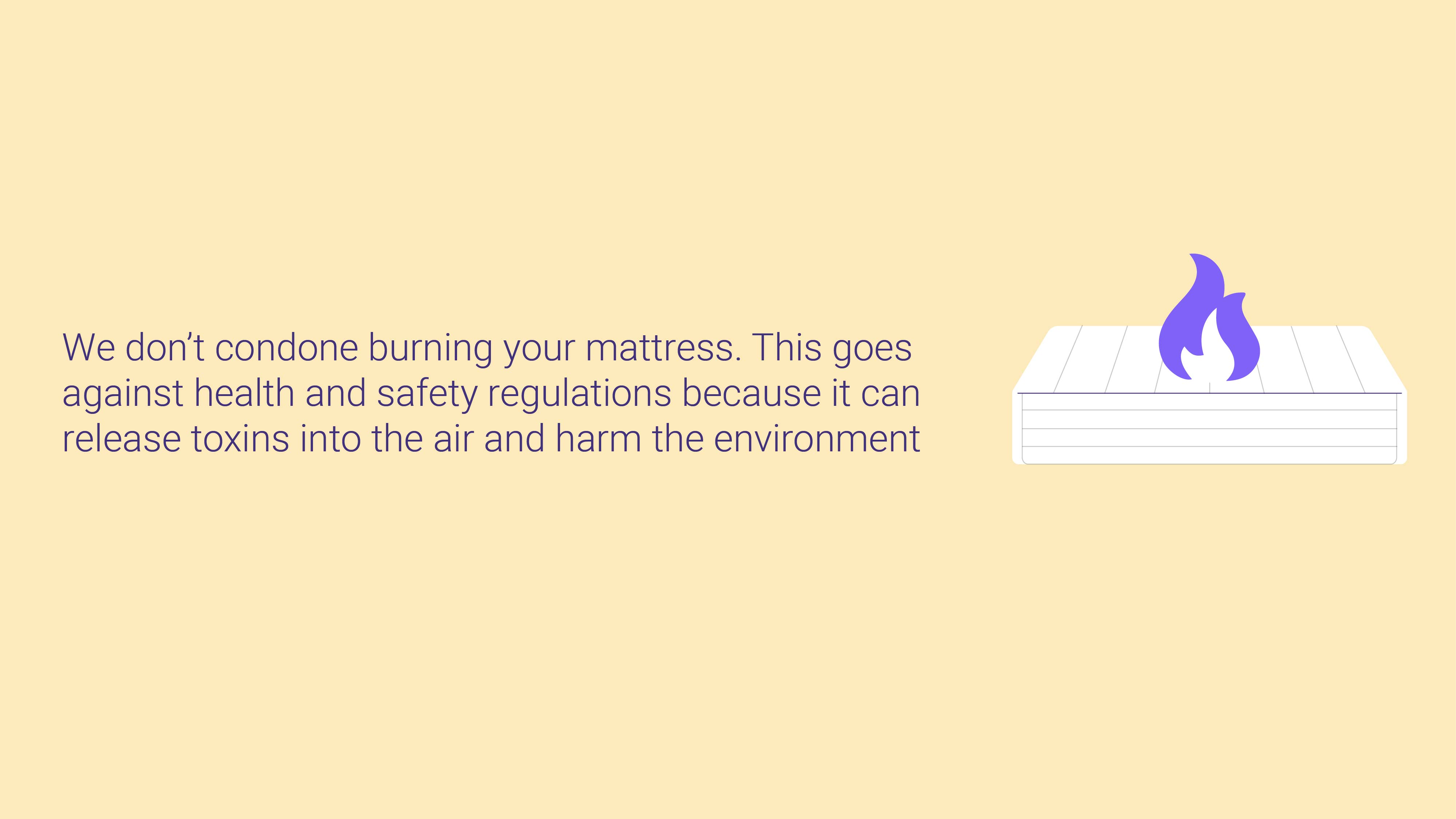
How to Dispose of a Mattress

According to the United States Mattress Recycling Council, around 15 to 20 million mattresses are disposed of every year in America. Those are just the beds disposed of properly. Tons more are left on the curbside, dumped in public lands, or tossed into the middle of lakes.
In this article, we will explore how to dispose of a bed properly and any alternatives to recycling mattresses. We’ll also discuss what not to do when getting rid of a mattress.
Getting Rid Of Your Old Mattress

Now that you have a new mattress, what do you do with the old one? Stashing it up in the attic or the garage isn’t the best way to get rid of a bed. Actually, it isn’t getting rid of it at all.
Taking measures to place a mattress in a recycling facility or landfill will prevent your living areas from looking crowded. Removal services are available almost everywhere, though it make cost a lot more if you live in a more rural area.
Some organizations will recycle your mattress for you, or you can do it yourself. Below you’ll learn all the ways you can properly dispose of your mattress.
Mattress Removal
A quick internet search will display several junk or mattress removal companies willing to coordinate a pick-up. You can choose between a specialized local charity or international organization that can help people on a larger scale.
These organizations offer pick-up services for a fee. Other junk companies charge removal by weight or flat cost per item. For large items, the price is higher.
Mattress Recycling
Since the government has taken an interest in reducing landfill waste, several organizations, like Bye Bye Mattress, have begun to successfully repurpose beds and box springs.
If it’s too old or beaten up to donate, recycling the mattress can prove good for the environment and your wallet. As it turns out, 80% to 90% of the bed— foam, steel springs, and wood— is reusable. Here are some of the ways mattresses are recycled:
- Scrap wood is transformed into landscaping material
- Foam is shredded to be used as padding or insulation
- Springs are melted down for machinery, nails, and screws
Disassembling the mattress yourself can earn you a few bucks at the recycling center. If you’re not good with your hands or don’t have time, there are companies willing to repurpose the bed for you.
So, before you chuck your old mattress in the dumpster, try repurposing the bed yourself or making a call to the local recyclers.
For a small fee, organizations such as 1-800-Got-Junk will load up your bed, take it to their facilities, and pull it apart for scrap metal and other materials. Just schedule a mattress pickup.
Some furniture stores will accept old mattresses as part of their recycling programs. All you have to do is drop off the bed at the store’s designated spot and leave the rest to them.
Mattress Donation
While we highly encourage using recycling services, donating is another good option — especially if the bed is still in good shape. Many donation centers have stopped taking mattresses due to sanitary bed laws to stop the spread of bacterial infections, bed bugs, dust mites, and allergens. Check with your local donation center before dropping your mattress off.
Good condition beds free of stains, bed bugs, dust mites, mold, and mildew are welcome at many local charities needing mattresses. Some local charities you may consider are:
- Furniture banks
- Religious organizations
- Homeless shelters
- Women and children centers
You can even give the mattress to someone you know who is in need, like a friend or family member.
There are international organizations you can donate to as well. We highly suggest giving your old mattress to a non-profit charity, such as Habitat for Humanity, as the bed will most likely go to someone in need.
What Not To Do
Giving your mattress to someone in need is a great way to repurpose your old bed, but selling it can go against sanitary bedding laws in your state.

Another thing we don’t condone is burning your mattress. This goes against health and safety regulations because it can release toxins into the air and harm the environment. You’re much safer just dropping it off at the landfill or recycling center.
Additionally, avoid illegally dumping your mattress into undesignated waste disposal areas. It’s environmentally harmful and can result in a hefty fine.
Mattress Reselling?
Even though bed reselling is legal in some states, we suggest not choosing this option for hygienic reasons. After you’ve slept on a mattress for ten years, it’s filled with bacteria, body oils, dandruff, and other foreign particles.
If you think about it, you’re not just selling your bed—you’re also selling the bacteria and dandruff you’ve shed as well. While you could sleep on the bed just fine, your buyer’s health may be affected by left behind allergens.
The bacteria and other foreign particles are a significant reason why mattress companies can no longer resell used mattresses. It isn’t sanitary. Besides, if a product has become too old and dirty for you to use it, you shouldn’t sell it to someone else.
If you think your old mattress is usable, we highly suggest donating the bed to a non-profit charity. You can find them locally or internationally. Donation to these places will ensure your donation goes to someone in genuine need.
When To Get A New Mattress
The National Sleep Foundation recommends replacing your mattress every 7 to 10 years. In reality, when you buy a new bed depends on varying factors such as the bed’s condition and your sleep quality.
If you’re constantly waking up with body aches and can’t seem to get enough sleep, you probably need a new mattress. Sagging, indentations, and severe wear and tear are a significant indicator your bed is ready for retirement.
Escaped fiberglass is another reason to replace the mattress. Normally, fiberglass is hidden within the mattress and doesn’t touch the person sleeping on it. However, if the mattress cover wears down, fiberglass particles may come through and cause discomfort. Cleaning up fiberglass can be challenging as well, so even if you don’t have a leak yet, you may want to replace the mattress with a fiberglass-free model.
Still, to help avoid fiberglass leakage, you can use a leakproof and waterproof mattress protector, which acts as a barrier and keeps the fiberglass from escaping if the cover gets worn out.
Warranty Information
Before you do anything with your old mattress, check the mattress warranty. The company may offer complementary buybacks or disposal services.
If the mattress is still under the warranty’s time frame, you’ll want to check to see if you can file a warranty claim.
Most warranties will replace the mattress if it experiences deterioration due to material or manufacturing defects. More specifically, warranties cover:
- Sagging or indentations below a specific depth
- Broken or bent coils
- Springs poking through the cover
- Seams pulling apart
- Bunching and lumping fabric
Be aware warranties don’t cover:
- Indentations less than the depth requirements
- Lumpiness from long term use
- Discoloration
- Any damage caused by you, the owner
Your warranty will be voided if the mattress has stains, is used on an unsupportive foundation, is no longer in your possession, or if you removed the law tag. For dual-sided mattresses failure to rotate the bed will also result in a voided warranty. To prevent damaging your bed, we recommend investing in a durable mattress protector.
Another thing to keep in mind is some warranties are prorated and others are not. Choosing between prorated and non-prorated is a consideration worth debating before you decide on a bed. A prorated warranty usually goes into effect after a certain number of years (usually 10), and after that period, the owner is expected to pay a percentage of the repair costs.
Frequently Asked Questions
How can I get rid of my old mattress for free?
The best way to get rid of your mattress for free is to donate it. If you cannot transport the bed yourself, many charitable organizations offer free donation pickups. Keep in mind, not all donation centers will accept used mattresses, and you should never donate your bed if it’s in poor shape.
Can I put a mattress out for garbage?
Typically, you cannot just put a mattress out for garbage. Mattresses are big and bulky and should be recycled, not thrown in the trash. Leaving a mattress by the trash cans when it’s not meant to be picked up by the local waste management company can also result in a fine.
That said, local waste management companies often have a “heavy trash day” once a month, and most people can get away with tossing their mattresses on heavy trash day.
When should I get rid of my mattress?
Mattresses usually last around 7 to 10 years, but they sometimes need to be tossed earlier when they become stained or lumpy. If you find it hard to get a good night’s sleep on your bed, it’s time for a new mattress. The whole point of a mattress is to deliver better sleep—when it’s not serving its purpose, it’s time for a replacement.
Can you put a new mattress on an old mattress?
Instead of buying a mattress foundation or box spring, some shoppers place their new mattress on told of their old to give their bed extra height. While this is a cost-effective solution, it’s not recommended because an old mattress cannot provide the right kind of support for your new bed. Most mattresses need solid, sturdy support, and an old mattress isn’t necessarily solid or sturdy. Plus, old mattresses contain dirt and germs you don’t want to infiltrate your new bed.
What happens to recycled mattresses?
Mattresses contain several materials that can easily be broken down or repurposed. Foam, latex layers, and steel coils in mattresses are recycled, cotton and other textiles are turned into clothing, and wood parts are put through a chipper.
Did We Answer Your Question?
If you’re environmentally savvy or want to help someone less fortunate, we encourage you to donate your old mattress to a local charity. If you’re concerned your bed is no longer supportive or healthy for anyone to sleep on, recycle it.
